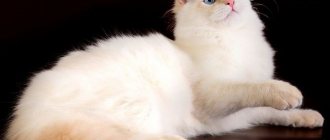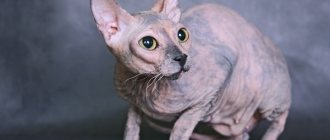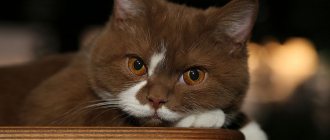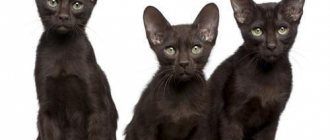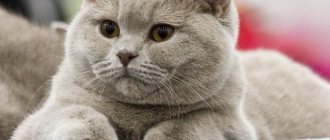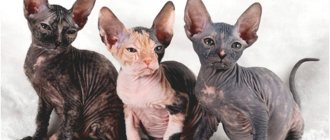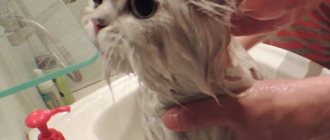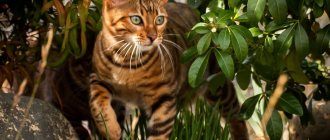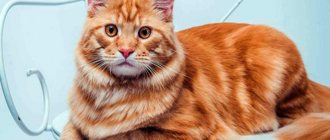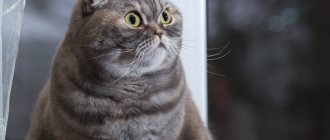Among lovers and admirers of the cat family, a breed of cats without a tail is popular. These types of animals are also called bobtails, which translated from English means “cats with a cropped tail.” Short-tailed pets are ideal for families with small children, because the tail will be saved from the child, and the baby himself will be saved from dangerous scratches.
Types of rocks, their names and characteristics
Mekong Bobtail
This is the name of the stub-tailed breed, whose ancestor was the Siamese cat and cat. The variety was bred in Russia, but due to its external resemblance to Siamese cats, Mengkong Bobtail cats are often called Thai. Pedigree kittens are born with a short tail, and the configuration of the tail will always be different for each individual animal. Bobtails of this variety are real long-livers. The pet becomes strongly attached to its owner and loves to communicate constantly, which is especially important for people suffering from loneliness.
American Bobtail
Officially, this breed of cats with a short tail was registered in the 90s of the twentieth century. Until now, cats of the breed with short tails were considered inferior and defective. This fluffy beauty is the dream of many cat lovers. Kittens and adults have a good-natured, affectionate character. In addition, the animal gets along well with other pets. The color of the fur can be varied - red, gray, brown, black, tabby.
Manx cat
Some individuals of this species may still be born with such a process.
This breed of tailless cats is not always born with docked small tails. Some animals at birth have a long tail that looks like a fan. But most representatives are still short-tailed. Cats with flat spots where the “fifth limb” grows look as if they have lost an important appendage as a result of surgery.
The Manx cat rarely produces healthy offspring; adult cats are often infertile. The pet's character is playful and friendly. The animal quickly becomes attached to its owner and willingly plays with children. Fluffy cats are very active, they love to jump around the house, climbing to the highest places. Thanks to its developed intelligence, a kitten or adult cat is easy to train. The varieties of this breed have the following names:
- risen;
- stumpy.
Hybrid breeds
Tailless hybrid cats are in a separate category. The names and characteristics of each variety are as follows:
Such pets are kind and affectionate in nature towards people.
- Pixie bob. Representatives with chopped off tails are similar in appearance to a lynx. The animal has 7 toes on its front paws and 5 on its hind paws. A cat of this variety can be fluffy or smooth-haired. The character is flexible, calm, balanced.
- Skiff toy bob. Cats with a small pom-pom bunny tail are very cute and friendly creatures, similar in appearance to a Siamese cat.
- Oooh-bob. An animal with a docked tail, whose ancestors are the Siamese and Manx cats. This is an experimental breed that has an affectionate and friendly personality and a sweet, cute appearance.
- Snow bob. The variety is distinguished by an absolutely snow-white coat. The pet also has a good-natured character and gets along well with children and other pets.
- Twisty. It looks like a kangaroo because its hind legs are much longer than its front legs. Despite this feature, the animal gets along with its owner and loves other family members.
Japanese Bobtail
In ancient times, the Japanese believed that cats with a tail standing upright were friends of the devil and it was in this appendage that all the evil power resided. Therefore, cats were feared, shunned and even destroyed. However, in the late 60s of the last century, tailless cats were introduced to the world, which, according to Japanese beliefs, brought happiness and good luck. The Japanese Bobtail has an easy-going character, so he immediately becomes everyone's pet, ready to cuddle in his owner's arms and have fun playing with his children.
Kurilian Bobtail
In case of danger, such a pet will not offend anyone.
Another popular variety, characterized by docked short tails.
The tail may be slightly crooked, resembling a spiral, or similar to a stump or broom. The ancestors of the Kurilian are the Japanese bobtail and the Siberian cat. A representative of this breed resembles a dog in habits. If an animal feels threatened, it will immediately rush at the enemy, defending the territory, the owner, and itself. In addition, Kurils love to talk, tell their owner about their day, and tell about their problems.
Cymrics and Manx cats
Each breed has distinctive features and its own character. Tailless cats require special care. Let's take a closer look at each of the existing breeds, its features and characteristics.
Manx cat
Manx cats have no tail at all. The animal is named after its homeland - the Isle of Man. According to local legends, cats with no tails were discovered here in 1500. The Manx cat is believed to bring good luck to its owner. Tailless cats from the Isle of Man have become popular around the world since the 1920s.
Appearance
The Manx cat has the following characteristics:
- The head and body of the animal are rounded, the paws are powerful;
- The coat is thick and quite fluffy;
- There are no restrictions on color, there are plain, striped, spotted individuals;
- Maximum weight – 5 kg.
This is interesting! The average lifespan of a Manx cat is 13 years.
Care and price
The breed does not require expensive or special care. It is enough to visit the veterinarian regularly, get vaccinated, and maintain a balanced diet.
The average cost of a Manx kitten is 30 thousand rubles.
Cymric
One of the most famous breeds of cats without a tail is the Cymrik. They are also called Welsh cats. They first became known in the 17th century.
Appearance
- They have very thick, fluffy hair, which is why they look large;
- The muzzle has a wide shape, which is due to the long hair on the cheeks;
- The average weight of Cymrics is 3 kg;
- The front legs are slightly shorter than the hind legs;
- The body has a round shape.
This is interesting! The peculiarity of the length ratio between the front and hind legs allows the Cymric to become excellent long-distance jumpers.
Care and price
Cymrik is a short-tailed cat with fluffy fur of varying lengths all over her body. In this regard, the cat must be regularly bathed and combed, otherwise the hair will roll into clumps.
The cost of Welsh cat kittens starts from 23 thousand rubles. and higher, depending on the characteristics of the individual.
Health and illness
There is an opinion that cats with crooked, cropped tails are defective and inferior. However, it is not. Despite the unusual body structure, the animal is in fairly good health. It is important to know that bobtailed felines do not have genetic or congenital diseases. However, with improper care and maintenance, cats suffer from acquired diseases, of which the most common are:
- proctitis;
- urolithiasis disease;
- Manx syndrome, which causes problems with the development of the spine;
- lidosis
The most famous representative is the Bobtail
Short-tailed cats are not widespread, but despite their limited fame, the most famous is the bobtail cat. It has its own subspecies: Japanese, American, Kuril. All of them are distinguished by a rudimentary tail. Body structure, muscles, character, habits, each breed has its own unique feature. See popular cat breeds with photos and names.
Japanese Bobtail
A beautiful and graceful animal with fluffy and thick fur. The body is of regular graceful shape, the muzzle is pointed. The short tail meets the breed standards and does not exceed 12 cm. Its characteristic feature is the shape: curled in the shape of a donut.
Limbs of different lengths: the front ones are shorter than the back ones. Due to their powerful hind legs, they can easily conquer the highest places.
The character is friendly, easy to train, so can often be seen on a leash. They are interested in new places. He easily becomes attached to his owner and makes contact easily. It can sometimes raise its paw as a sign of greeting.
American Bobtail
Externally, there is a significant difference compared to its Japanese counterpart: the body is dense, muscular, large, powerful paws, round muzzle. Tail length: to the beginning of the hind legs. The undercoat varies: long and fluffy or short, hard. The main representative is considered to be a cat with a tabby coloration (alternating light and dark stripes).
Representatives are distinguished by their good nature, good disposition, kindness and tolerance towards children. Like true cats, they do not accept restrictions on their territory and character.
Kurilian Bobtail
Representative of the Russian diaspora. Obtained by crossing a Japanese and Siberian ancestor. Inherited a powerful body and added a love of water and endurance in the winter cold. The coat is short, some are not too long, but shedding is not visually obvious.
Having acquired new character traits and tricks, these cats are able to successfully hunt both rats and fish. The intellect is quite developed, they love human communication. Having become attached to the owner, they will be faithful and devoted to him.
Maintenance and care
The frequency of the animal's visits to the litter box should be checked to avoid causing anal disease.
The breed of tailless cats is unpretentious in care and maintenance. However, due to the peculiarities of the body structure, the animal is predisposed to infectious diseases that affect the anus. Therefore, it is important for the owner to constantly monitor the pet’s well-being and pay attention to whether there are any problems with going to the toilet “in a big way.” After each visit to the tray, it is recommended to wipe the skin around the anus with a damp, alcohol-free wipe.
If the cat has short fur, he can take care of it himself without any problems. It is enough to comb your pet 1-2 times a week with a special brush to remove fallen hairs, particles of dead skin and dust. Long-haired representatives will have to be scratched more often - 3-4 times a week, and if the cat sheds, it is recommended to carry out the procedure daily, using a furminator. Eyes and ears should be wiped with a damp cotton swab as they become dirty. Nails are also trimmed if necessary. To do this, it is better to use special tweezers, scissors or a trimmer.
Bobtail cats love to walk in the fresh air. They get used to a leash without any problems, but it is better if the animal lives in a private house with a garden, bushes, and large stones. This way the cat will be able to freely develop its muscles, play and frolic as much as it wants.
Animals with short tails
The tail is a very important tool for an animal and not only a communication tool (for expressing emotions). It helps maintain balance, serves as a steering wheel and support. But sometimes mammals are born without this organ.
How cats got to the Isle of Man is unknown. To this day, the reason for the loss of the tail remains a mystery. But it was from them that amazing breeds of tailless and bob-tailed cats began to form. There are currently four subspecies of the Menskaya breed with different tail conditions:
- 1. Longs – long, full.
- 2. Stumpy – a slightly shortened version.
- 3. Rised – short, in the form of a pompom.
- 4. Rampi – completely absent.
We suggest you familiarize yourself with: Paraanal glands in cats, their functions, as well as the causes and treatment of the inflammatory process
All subspecies, with the exception of the tail, have a similar appearance: the coat is long, with a thick undercoat. Any fur color is allowed: from pure white to red with stripes of different shades. The body is dense, stocky, the paws are strong, the hind legs are longer than the front, which is why the animals have a “hare” gait. These creatures are calm, quiet, balanced. They feel good in large families and cannot stand loneliness.
What to feed?
High-quality and balanced nutrition is the basis for good health and proper development of short-tailed cats. The animal is not picky about food. If desired, you can feed your cat ready-made factory-made dry or wet food of premium and superpremium classes. But the pet will not refuse natural food. The daily diet must include lean boiled meat, steamed sea fish, cottage cheese, kefir, fermented baked milk, and natural yogurt. Porridge will help provide the body with energy: rice, oatmeal, buckwheat. For normal digestion, it is useful to add vegetables to your diet, such as pumpkin, zucchini, and cauliflower.
Caring for tailless cats
It is better to feed animals with natural food. It is important that the food is somewhat harsh: it can be cartilage, chicken hearts, stomachs. Since all short-tailed felines have a highly developed hunting instinct, their diet should not differ from their natural diet. But feeding only meat, in the absence of carbohydrates, is dangerous; intoxication (excess protein in the body) can occur.
Dairy products should also be included in the daily diet: milk, cottage cheese, kefir, yogurt, sour cream. To feed your cat, you can use ready-made dry food, but of good quality and in small quantities. There should always be fresh water in the drinking bowl.
Caring for animals is very easy: comb your pet’s fur once a week, wipe ears and eyes as needed. Since animals of these breeds are energetic, it is necessary to take care of the territory for active games.
Cats are in good health. Over the years, they may develop eye diseases, intestinal disorders, and diseases of the genitourinary system. Therefore, it is important to vaccinate your pet on time and visit the veterinarian regularly.
American Bobtail
American Bobtail breed history: The American Bobtail was bred in the USA in the 50s. XX century. The ancestor of the cat breed was the cat Yodi with a short bob tail, selected by enthusiastic felinologists on an Indian reservation in Arizona. At first they tried to breed this cat with Siamese cats to get a color point color. However, the offspring obtained as a result of such matings turned out to be non-viable. Then they began to breed the cat with cats of other breeds, and everything worked out.
The first American Bobtail standard was created in 1970, and in 1989 the breed was recognized by TICA.
American Bobtail Personality: American Bobtails are intelligent, sociable, active and unobtrusive.
The American Bobtail has shorthair and semi-longhair variations.
Diseases
The immunity of cats of this breed is enviable. But they also have weaknesses.
The first thing you should pay attention to is the ponytail, or more precisely, the area under it. At the very first inspection, find out whether there are any cracks, irritation or ulcers.
Such a short length is a prerequisite for the occurrence of an inflammatory process or prolapse of the anus. The Kurilian Bobtail should be examined regularly, and if damage is found, take it to a veterinarian for examination. Remember: if you feed your cat poorly, he will develop this kind of illness quickly.
Ordinary sea buckthorn oil helps to deal with small cracks: they lubricate the anus area with it and make sure that the cat does not lick it right away.
The second nuance: in Kuril Bobtails, the urine pH is significantly different from the urine of cats of other breeds (7-7.5 versus the usual 6-6.5). Therefore, they rarely suffer from urolithiasis of the alkaline type.
Timely and regular vaccination will help protect your pet from a number of diseases - rabies, rhinotracheitis, panleukopenia, calicivirus, leukemia, peritonitis. The kitten receives its first vaccinations at the nursery, but in the future you will have to learn the vaccination calendar and take your pet to the doctor yourself.
Information about the procedures is entered into the veterinary passport. You should not vaccinate yourself (if you do not have the appropriate education: a mistake can lead to serious consequences. Do not try to vaccinate your pet against all diseases at once: this is too much stress on the immune system!
Japanese Bobtail
The cat was bred in Japan and recognized in 1968. Can have any color. It is medium in size and has short, silky fur. In Japan, it was an object of worship due to its chopped tail. The Japanese believed that cats accumulated dark power in their tails and could break free over time. Therefore, cats without a tail were valued above all measures and were the only ones allowed into the house.
You can also distinguish between hybrid cat breeds that just so happen to have no tail or a very short tail. We will not describe them in detail, but we will simply list them so that if you wish, you can find information about them.
Mekong Bobtail (Thai Bobtail)
Mekong Bobtail breed history: The ancestors of the Mekong Bobtail were Siamese cats, brought to Europe from Siam in the 19th century. From those individuals came the Siamese, Thais, Orientals and our heroes - the Mekong Bobtail. In Thailand, cats with broken short tails were considered royal; in Europe and the USA they were discarded, but in Russia they were preserved. It was thanks to Russian feline enthusiasts that the Mekong Bobtail standard was approved in 2004.
Mekong Bobtail Personality: Mekongs are inquisitive, love to look people straight in the eye, and love cat play.
